child lock Acura RL 2001 3.5 Owner's Manual
[x] Cancel search | Manufacturer: ACURA, Model Year: 2001, Model line: RL, Model: Acura RL 2001Pages: 333, PDF Size: 4.28 MB
Page 8 of 333
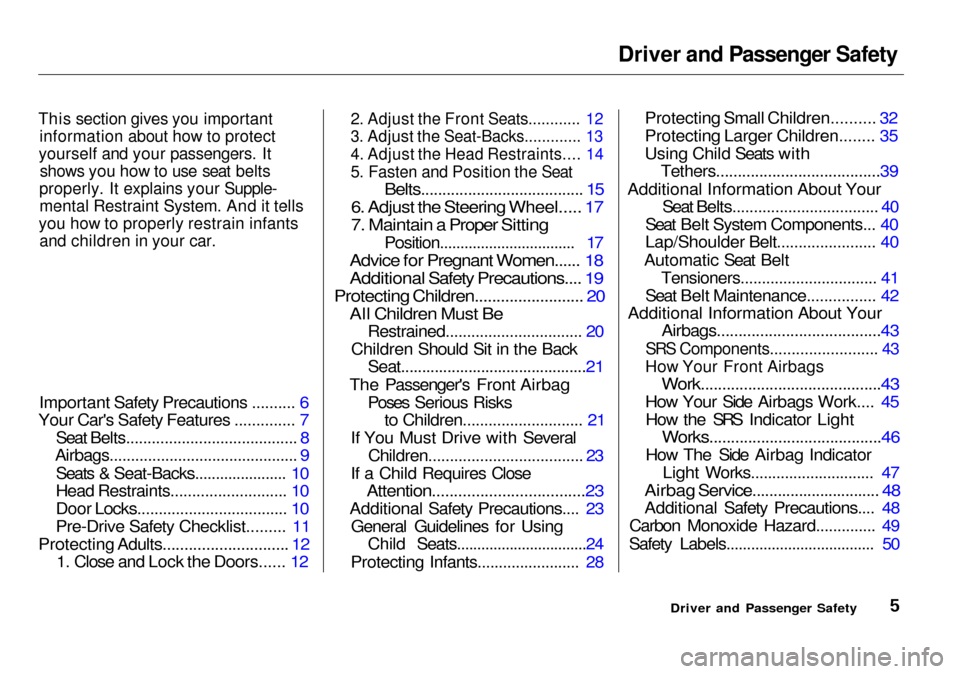
Driver and Passenger Safety
This section gives you important information about how to protect
yourself and your passengers. It
shows you how to use seat belts
properly. It explains your Supple-
mental Restraint System. And it tells
you how to properly restrain infants and children in your car.
Important Safety Precautions .......... 6
Your Car's Safety Features .............. 7
Seat Belts........................................ 8
Airbags............................................ 9
Seats & Seat-Backs...................... 10
Head Restraints........................... 10
Door Locks................................... 10
Pre-Drive Safety Checklist......... 11
Protecting Adults............................. 12
1. Close and Lock the Doors...... 12
2. Adjust the Front Seats............ 12
3. Adjust the Seat-Backs............. 13
4. Adjust the Head Restraints.... 14
5. Fasten and Position the Seat
Belts...................................... 15
6. Adjust the Steering Wheel..... 17
7. Maintain a Proper Sitting
Position................................. 17
Advice for Pregnant Women...... 18
Additional Safety Precautions.... 19
Protecting Children......................... 20
All Children Must Be
Restrained................................ 20
Children Should Sit in the Back
Seat............................................21
The Passenger's Front Airbag Poses Serious Risksto Children............................ 21
If You Must Drive with Several Children.................................... 23
If a Child Requires Close
Attention...................................23
Additional Safety Precautions.... 23 General Guidelines for Using Child Seats................................24
Protecting Infants........................ 28 Protecting Small Children.......... 32
Protecting Larger Children........ 35
Using Child Seats with
Tethers......................................39
Additional Information About Your
Seat Belts.................................. 40
Seat Belt System Components... 40
Lap/Shoulder Belt....................... 40
Automatic Seat BeltTensioners................................ 41
Seat Belt Maintenance................ 42
Additional Information About Your
Airbags......................................43
SRS Components......................... 43
How Your Front Airbags
Work..........................................43
How Your Side Airbags Work.... 45 How the SRS Indicator Light
Works........................................46
How The Side Airbag Indicator Light Works............................. 47
Airbag Service.............................. 48
Additional Safety Precautions.... 48
Carbon Monoxide Hazard.............. 49
Safety Labels.................................... 50
Driver and Passenger Safety
Page 14 of 333

Your Car's Safety Features
Pre-Drive Safety Checklist
To make sure you and your passengers get the maximum
protection from your car's safety
features, check the following each
time before you drive away: All adults, and children who have
outgrown child safety seats, are
wearing their seat belts and
wearing them properly (see page
15).
Any infant or small child is
properly restrained in a child seatin the back seat (see page 20). Front seat occupants are sitting
upright and as far back as possible
from the steering wheel and dashboard (see page 12).
Seat-backs are upright (see page
13).
Head restraints are properly
adjusted (see page 14). All doors are closed and locked
(see page 12). All cargo is properly stored or
secured (see page 176). The rest of this section gives more
detailed information about how you
can maximize your safety.
Remember, however, that no safetysystem can prevent all injuries or
deaths that can occur in severe
crashes, even when seat belts are
properly worn and the airbags deploy.
Driver and Passenger Safety
Page 15 of 333

Protecting Adults
Introduction
The following pages provide instructions on how to properly
protect the driver and other adult
occupants.
These instructions also apply to children who have outgrown childseats and are large enough to wear
lap/shoulder belts. (See page 35 for important additional guidelines on
how to properly protect larger
children.)
1. Close and Lock the Doors
After everyone has entered the car, be sure the doors are closed and
locked.
Your car has a door monitor light on
the instrument panel to indicate
when a specific door is not tightly
closed.
For safety, locking the doors reduces
the chance that a passenger,
especially a child, will open a door
while the car is moving and accidentally fall out. It also reduces
the chance of someone being thrown
out of the car during a crash.
For security, locked doors can
prevent an outsider from
unexpectedly opening a door when
you come to a stop.
See page 81 for how to lock the
doors.
2.Adjust the Front Seats
Any driver who sits too close to the steering wheel is at risk of being
seriously injured or killed by striking
the steering wheel or from being struck by an inflating front airbag
during a crash.
Driver and Passenger Safety
Page 26 of 333

Protecting Children
If You Must Drive with Several
Children
Your car has three seating positions in the back seat where children can
be properly restrained.
If you ever have to carry more than
three children in your car: Place the largest child in the front
seat, provided the child is large
enough to wear a seat belt
properly (see page 35). Move the vehicle seat as far to the
rear as possible (see page 12).
Have the child sit upright and well
back in the seat (see page 17). Make sure the seat belt is properly
positioned and secured (see page 15). If a Child Requires Close
Attention
Many parents say they prefer to put
an infant or small child in the front
passenger seat so they can watch the child, or because the child requires
attention.
Placing a child in the front seat
exposes the child to hazards from
the passenger's front airbag, and
paying close attention to a child distracts the driver from the
important tasks of driving, placing
both of you at risk.
If a child requires physical attention
or frequent visual contact, westrongly recommend that another
adult ride with the child in the back
seat. The back seat is far safer for a
child than the front. Additional Safety Precautions
Use childproof door locks to
prevent children from opening the
doors. Using this feature will
prevent children from opening the doors and accidentally falling out (see page 85).
Use the main power window
switch to prevent children from
opening the rear windows. Using
this feature will prevent children
from playing with the windows,
which could expose them to hazards or distract the driver (seepage 107).
CONTINUED
Driver and Passenger Safety
Page 27 of 333

Protecting Children
Lock all doors and the trunk when
your car is not in use. Children
who play in cars can accidentally get trapped inside the trunk.
Teach your children not to play in or around cars. Know how to
operate the emergency trunk
opener (US models only) and
decide if your children should be shown how to use this feature (see
page 87).
Keep car keys and remote
transmitters out of the reach of
children. Even very young
children learn how to unlock
vehicle doors, turn on the ignition, and open the trunk, which can
lead to accidental injury or death.
Do not leave children alone in your
vehicle. Leaving children without
adult supervision is illegal in most states and Canadian provinces,
and can be very hazardous. For
example, infants and small
children left in a vehicle on a hot
day can die from heatstroke. And
children left alone with the key in
the ignition can accidentally set
the vehicle in motion, possibly injuring themselves or others. General Guidelines for Using
Child Seats
The following pages give general guidelines for selecting and installingchild seats for infants and small
children.
Selecting a Child Seat
To provide proper protection, a child seat should meet three
requirements:
1. The child seat should meet safety
standards. The child seat should
meet Federal Motor Vehicle
Safety Standard 213 (FMVSS 213) or Canadian Motor Vehicle Safety
Standard 213 (CMVSS 213). Look
for the manufacturer's statement of compliance on the box and seat.
Driver and Passenger Safety
Page 32 of 333
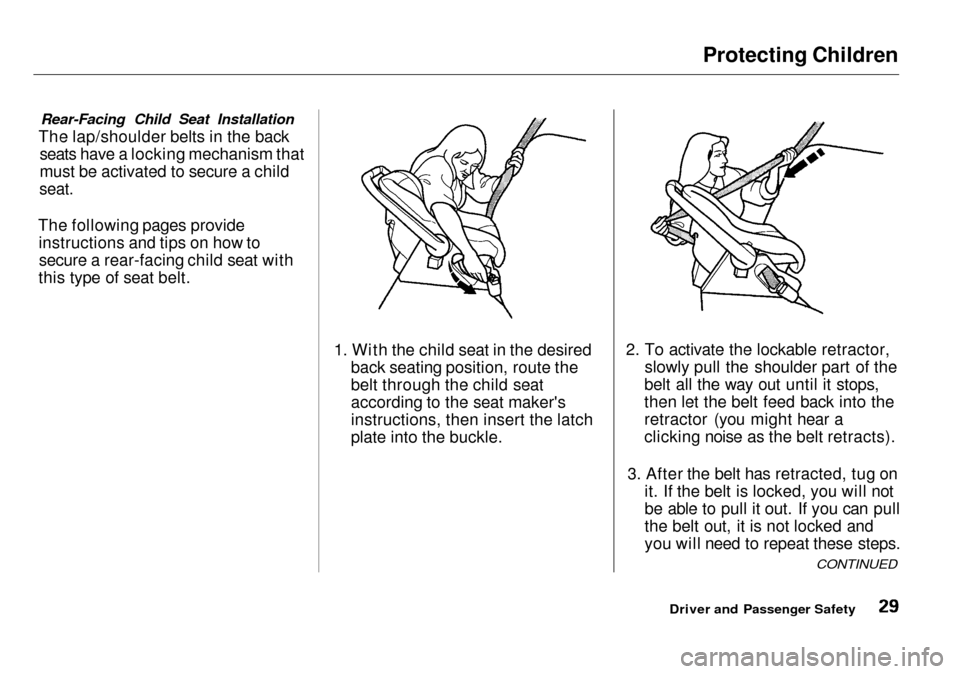
Protecting Children
Rear-Facing Child Seat Installation
The lap/shoulder belts in the back seats have a locking mechanism that
must be activated to secure a child
seat.
The following pages provide instructions and tips on how tosecure a rear-facing child seat with
this type of seat belt.
1. With the child seat in the desiredback seating position, route the
belt through the child seat
according to the seat maker's
instructions, then insert the latch
plate into the buckle. 2. To activate the lockable retractor,
slowly pull the shoulder part of the
belt all the way out until it stops,
then let the belt feed back into the
retractor (you might hear a
clicking noise as the belt retracts).
3. After the belt has retracted, tug on it. If the belt is locked, you will not
be able to pull it out. If you can pull
the belt out, it is not locked and
you will need to repeat these steps.
Driver and Passenger Safety
CONTINUED
Page 33 of 333
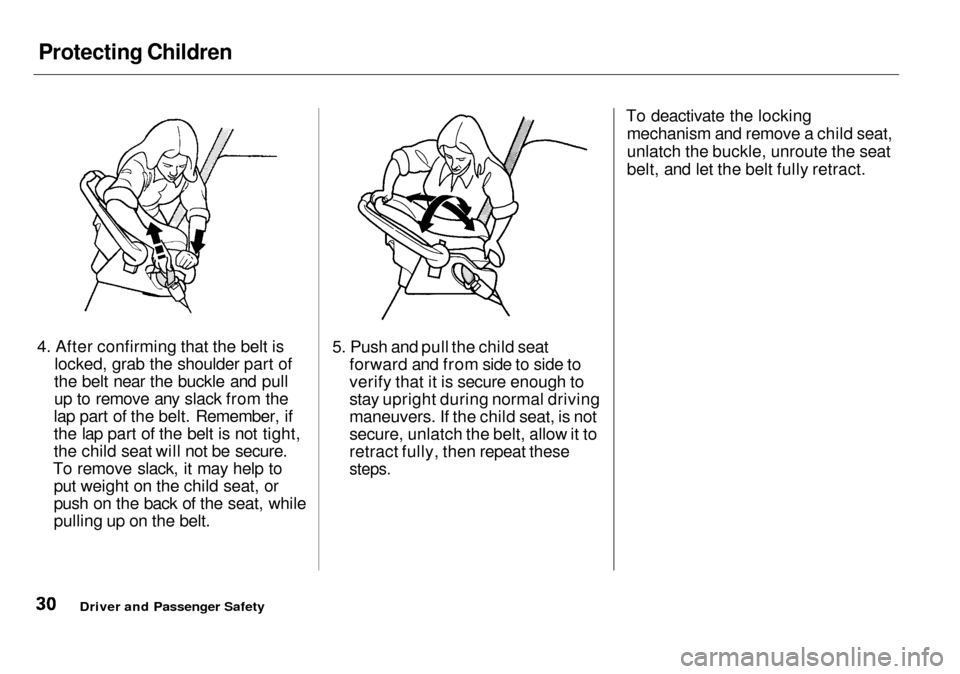
Protecting Children
4. After confirming that the belt is locked, grab the shoulder part of
the belt near the buckle and pull
up to remove any slack from the
lap part of the belt. Remember, if
the lap part of the belt is not tight,
the child seat will not be secure.
To remove slack, it may help to put weight on the child seat, or
push on the back of the seat, while
pulling up on the belt. 5. Push and pull the child seat
forward and from side to side to
verify that it is secure enough to
stay upright during normal driving
maneuvers. If the child seat, is not
secure, unlatch the belt, allow it to
retract fully, then repeat these
steps.
To deactivate the locking
mechanism and remove a child seat,
unlatch the buckle, unroute the seat
belt, and let the belt fully retract.
Driver and Passenger Safety
Page 34 of 333
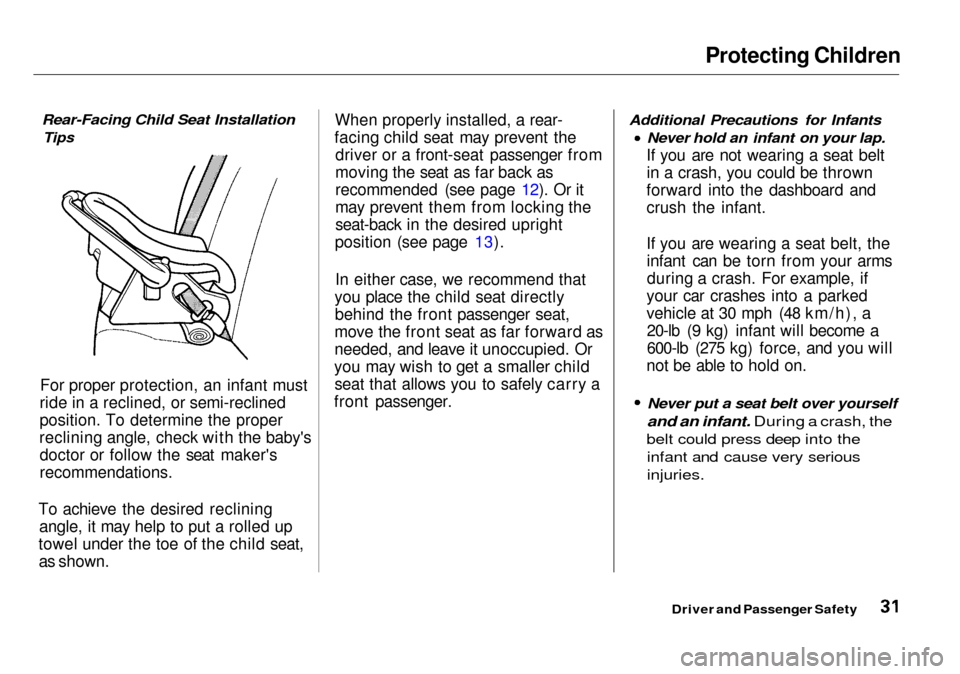
Protecting Children
Rear-Facing Child Seat Installation
Tips
For proper protection, an infant must
ride in a reclined, or semi-reclined
position. To determine the proper
reclining angle, check with the baby's doctor or follow the seat maker's
recommendations.
To achieve the desired reclining angle, it may help to put a rolled up
towel under the toe of the child seat, as shown. When properly installed, a rear-
facing child seat may prevent the driver or a front-seat passenger from
moving the seat as far back as
recommended (see page 12). Or it
may prevent them from locking the
seat-back in the desired upright
position (see page 13).
In either case, we recommend that
you place the child seat directly behind the front passenger seat,
move the front seat as far forward as
needed, and leave it unoccupied. Or
you may wish to get a smaller child seat that allows you to safely carry a
front passenger.
Additional Precautions for Infants
Never hold an infant on your lap.
If you are not wearing a seat belt in a crash, you could be thrown
forward into the dashboard and
crush the infant.
If you are wearing a seat belt, the infant can be torn from your arms
during a crash. For example, if
your car crashes into a parked
vehicle at 30 mph (48 km/h), a 20-lb (9 kg) infant will become a
600-lb (275 kg) force, and you will
not be able to hold on.
Never put a seat belt over yourself
and an infant. During a crash, the
belt could press deep into the infant and cause very serious
injuries.
Driver and Passenger Safety
Page 36 of 333
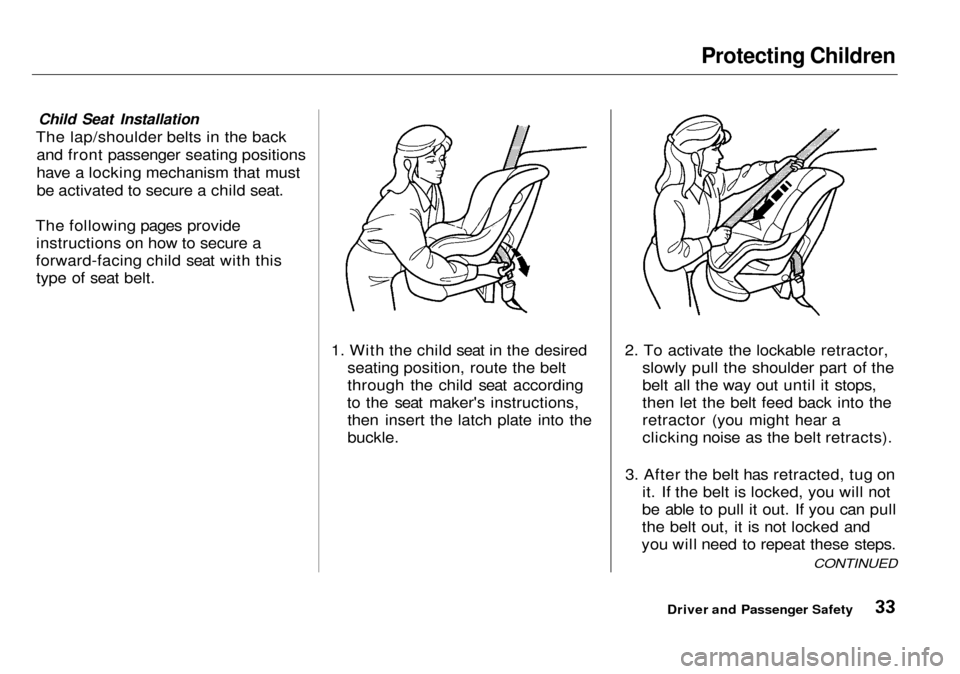
Protecting Children
Child Seat Installation
The lap/shoulder belts in the back and front passenger seating positions
have a locking mechanism that must
be activated to secure a child seat.
The following pages provide instructions on how to secure a
forward-facing child seat with this type of seat belt.
1. With the child seat in the desiredseating position, route the belt
through the child seat according
to the seat maker's instructions, then insert the latch plate into the
buckle. 2. To activate the lockable retractor,
slowly pull the shoulder part of the
belt all the way out until it stops,
then let the belt feed back into the
retractor (you might hear a
clicking noise as the belt retracts).
3. After the belt has retracted, tug on it. If the belt is locked, you will not
be able to pull it out. If you can pull
the belt out, it is not locked and
you will need to repeat these steps.
Driver and Passenger Safety
CONTINUED
Page 37 of 333
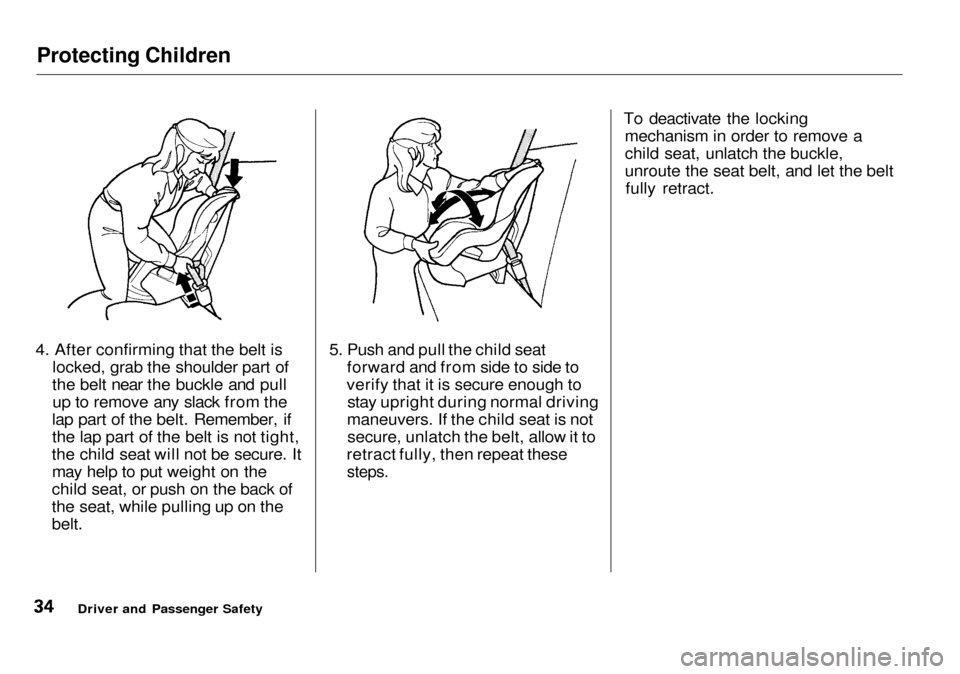
Protecting Children
4. After confirming that the belt is locked, grab the shoulder part of
the belt near the buckle and pull up to remove any slack from the
lap part of the belt. Remember, if
the lap part of the belt is not tight,
the child seat will not be secure. It may help to put weight on the
child seat, or push on the back of
the seat, while pulling up on the
belt. 5. Push and pull the child seat
forward and from side to side to
verify that it is secure enough to stay upright during normal driving
maneuvers. If the child seat is not secure, unlatch the belt, allow it to
retract fully, then repeat these
steps.
To deactivate the locking
mechanism in order to remove a
child seat, unlatch the buckle,
unroute the seat belt, and let the beltfully retract.
Driver and Passenger Safety